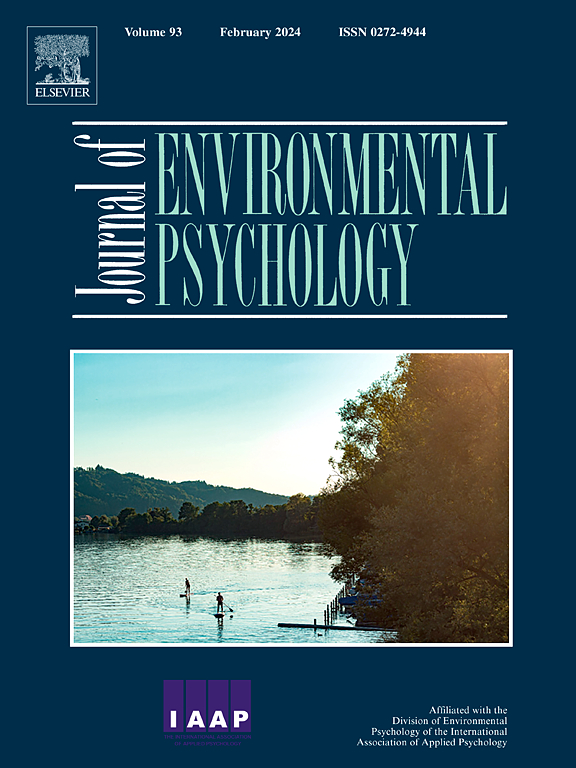Is greenspace in the eye of the beholder? Exploring perceived and objective greenspace exposure effects on mental health
IF 6.1
1区 心理学
Q1 ENVIRONMENTAL STUDIES
引用次数: 0
Abstract
Background
This study explores the relationship between greenspace and perceived stress, anxiety, and depression, and specifically how perceived and objective greenspace exposure relate to these outcomes. It also explores whether race and socioeconomic status (SES) influence perceived and objective greenspace exposure.
Methods
We used structural equation models (SEMs) to assess the combined impacts of perceived greenspace (a latent construct that included greenspace abundance, visibility, access, usage, quality) and objective greenspace (NDVI within a 300-m buffer of residence) exposures on mental health outcomes (perceived stress, anxiety, and depression), adjusted for SES (using a latent variable that combined income, education, employment), race, ethnicity, age, and cohabiting status from a cross-sectional survey on greenspace and mental health in Denver, CO that ran from November 2019 to April 2021. We compared the strength of pathways between perceived and objective greenspace measures and mental health outcomes, as well as those between SES/race/ethnicity and greenspace measures.
Results
Perceived greenspace exposure was directly associated with reduced anxiety; objective greenspace was only indirectly associated with reduced anxiety, through perceived greenspace. Perceived—but not objective—greenspace exposure was associated with lower depression with borderline statistical significance. SES was statistically significantly associated with higher objective greenspace (a direct impact) and perceived greenspace (direct impact and indirect impact mediated by objective greenspace), which suggests that some, but not all, of differential perceptions of greenspace exposure by SES are due to differential levels of objective greenspace exposure by SES.
Conclusion
Our study shows that perceived greenspace exposure may be an integral part of how objective greenspace exposure confers mental health benefits, particularly anxiety. SES may also play a role not just in influencing objective greenspace exposure, but also in shaping peoples’ perceptions of greenspace, which are unmeasured in most objective greenspace exposure measures.
绿地是否尽收眼底?探索绿地暴露对心理健康的感知和客观影响
背景本研究探讨了绿地与感知压力、焦虑和抑郁之间的关系,特别是感知和客观绿地暴露与这些结果之间的关系。研究还探讨了种族和社会经济地位(SES)是否会影响感知绿地和客观绿地暴露。方法我们使用结构方程模型(SEMs)来评估感知绿地(包括绿地丰度、可见度、可及性、使用率和质量的潜在结构)和客观绿地(居住地 300 米缓冲区内的 NDVI)暴露对心理健康结果(感知压力、焦虑和抑郁)的综合影响、在科罗拉多州丹佛市进行的一项关于绿地与心理健康的横断面调查显示,从 2019 年 11 月到 2021 年 4 月,在对 SES(使用结合了收入、教育、就业的潜变量)、种族、民族、年龄和同居状况进行调整后,我们得出了 "感知到的压力、焦虑和抑郁 "这一结果。我们比较了感知绿地和客观绿地指标与心理健康结果之间的路径强度,以及社会经济地位/种族/民族与绿地指标之间的路径强度。结果感知绿地暴露与焦虑减少直接相关;客观绿地仅通过感知绿地与焦虑减少间接相关。感知到的绿地与抑郁程度的降低有关,但与客观绿地无关,其相关性在统计学上呈边缘显著性。在统计学上,社会经济地位与较高的客观绿地(直接影响)和感知绿地(直接影响和由客观绿地介导的间接影响)明显相关,这表明,社会经济地位对绿地暴露的不同感知,有一部分(但并非全部)是由于社会经济地位对客观绿地暴露水平的不同造成的。社会经济地位可能不仅在影响客观绿地暴露方面发挥作用,还在塑造人们对绿地的感知方面发挥作用,而大多数客观绿地暴露测量方法都无法测量人们对绿地的感知。
本文章由计算机程序翻译,如有差异,请以英文原文为准。
求助全文
约1分钟内获得全文
求助全文
来源期刊

Journal of Environmental Psychology
Multiple-
CiteScore
10.60
自引率
8.70%
发文量
140
审稿时长
62 days
期刊介绍:
The Journal of Environmental Psychology is the premier journal in the field, serving individuals in a wide range of disciplines who have an interest in the scientific study of the transactions and interrelationships between people and their surroundings (including built, social, natural and virtual environments, the use and abuse of nature and natural resources, and sustainability-related behavior). The journal publishes internationally contributed empirical studies and reviews of research on these topics that advance new insights. As an important forum for the field, the journal publishes some of the most influential papers in the discipline that reflect the scientific development of environmental psychology. Contributions on theoretical, methodological, and practical aspects of all human-environment interactions are welcome, along with innovative or interdisciplinary approaches that have a psychological emphasis. Research areas include: •Psychological and behavioral aspects of people and nature •Cognitive mapping, spatial cognition and wayfinding •Ecological consequences of human actions •Theories of place, place attachment, and place identity •Environmental risks and hazards: perception, behavior, and management •Perception and evaluation of buildings and natural landscapes •Effects of physical and natural settings on human cognition and health •Theories of proenvironmental behavior, norms, attitudes, and personality •Psychology of sustainability and climate change •Psychological aspects of resource management and crises •Social use of space: crowding, privacy, territoriality, personal space •Design of, and experiences related to, the physical aspects of workplaces, schools, residences, public buildings and public space
 求助内容:
求助内容: 应助结果提醒方式:
应助结果提醒方式:


